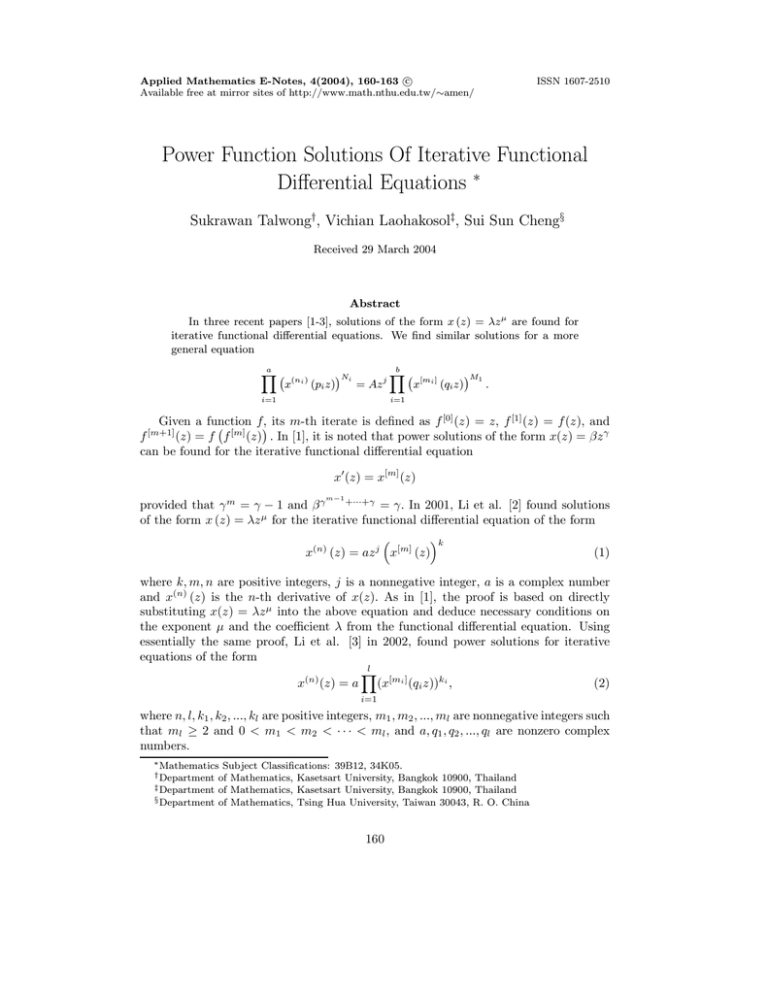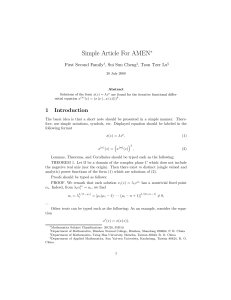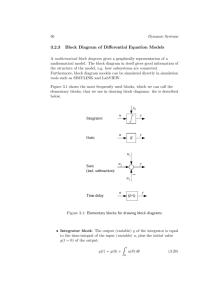Document 10677226
advertisement

Applied Mathematics E-Notes, 4(2004), 160-163 c Available free at mirror sites of http://www.math.nthu.edu.tw/∼amen/ ISSN 1607-2510 Power Function Solutions Of Iterative Functional Differential Equations ∗ Sukrawan Talwong†, Vichian Laohakosol‡, Sui Sun Cheng§ Received 29 March 2004 Abstract In three recent papers [1-3], solutions of the form x (z) = λz µ are found for iterative functional differential equations. We find similar solutions for a more general equation a b x(ni ) (pi z) Ni = Az j i=1 x[mi ] (qi z) M1 . i=1 Given a function f, its m-th iterate is defined as f [0] (z) = z, f [1] (z) = f (z), and f (z) = f f [m] (z) . In [1], it is noted that power solutions of the form x(z) = βz γ can be found for the iterative functional differential equation [m+1] x (z) = x[m] (z) m−1 +···+γ = γ. In 2001, Li et al. [2] found solutions provided that γ m = γ − 1 and β γ µ of the form x (z) = λz for the iterative functional differential equation of the form x(n) (z) = az j x[m] (z) k (1) where k, m, n are positive integers, j is a nonnegative integer, a is a complex number and x(n) (z) is the n-th derivative of x(z). As in [1], the proof is based on directly substituting x(z) = λz µ into the above equation and deduce necessary conditions on the exponent µ and the coefficient λ from the functional differential equation. Using essentially the same proof, Li et al. [3] in 2002, found power solutions for iterative equations of the form l (n) x (z) = a (x[mi ] (qi z))ki , (2) i=1 where n, l, k1 , k2 , ..., kl are positive integers, m1 , m2 , ..., ml are nonnegative integers such that ml ≥ 2 and 0 < m1 < m2 < · · · < ml , and a, q1 , q2 , ..., ql are nonzero complex numbers. ∗ Mathematics Subject Classifications: 39B12, 34K05. of Mathematics, Kasetsart University, Bangkok 10900, Thailand ‡ Department of Mathematics, Kasetsart University, Bangkok 10900, Thailand § Department of Mathematics, Tsing Hua University, Taiwan 30043, R. O. China † Department 160 S. Talwong et al. 161 In this note, we prove the existence of power solutions for the more general equation x(n1 ) (p1 z) N1 · · · x(na ) (pa z) Na = Az j x[m1 ] (q1 z) M1 · · · x[mb ] (qb z) Mb (3) where a, b, N1 , . . . , Na , M1 , . . . , Mb and n1 , ..., na , m1 , ..., mb are positive integers such that n1 > n2 > · · · > na and m1 > m2 > · · · > mb . The number j is a nonnegative integer and A, p1 , . . . , pa , q1 , . . . , qb are nonzero complex numbers. By taking a = b = 1, N1 = 1, M1 = k and p1 = q1 = 1 in (3), we obtain (1). By taking a = 1, b = l, N1 = 1, p1 = 1, Mi = ki for i = 1, 2, . . . , l in (3), we obtain (2). For the sake of convenience, we employ the notation (µ)n = µ(µ − 1) · · · (µ − n + 1). THEOREM 1. Let Ω be a domain in the complex plane C which does not include the negative real axis nor the origin. Put s (N, a) = N1 +· · ·+Na , s (M, b) = M1 +· · ·+Mb and s (N n, a) = N1 n1 + · · · + Na na . Let µ1 , . . . , µm , where 1 ≤ m ≤ m1 , be distinct roots of the polynomial f (z) = M1 z m1 + · · · + Mb z mb − s (N, a) z + s (N n, a) + j. (4) If s (N, a) ≤ s (M, b), then (3) has m distinct, single-valued, nonzero, analytic power solutions of the form xi (z) = λi z µi , i = 1, 2, . . . , m; z ∈ Ω, where and λi = A a Nl µi l=1 pl m Ml µi l b l=1 ql Bi = s(N,a−1) s(N,1) Bi (µi )s(N,a) (µi − na )na−1 −na · · · (µi − n2 )n1 −n2 na , (5) 1 − µi . s(M, b) + s(N n, a) − s(N, a) + j PROOF. Substituting x (z) = λz µ into (3), we obtain s(N,a−1) s(N,1) (µ − na )na−1 −na · · · (µ − n2 )n1 −n2 z s(N,a)µ−s(Nn,a) = Qµ Aλc z r , Pµ λs(N,a) (µ)s(N,a) na where b c= l=1 Ml (1 + µ + · · · + µml −1 ), b Ml µml + j, r= l=1 a plNl µ , Pµ = l=1 162 Power Function Solutions and b ml qlMl µ . Qµ = l=1 This leads to two requirements s(N,a−1) s(N,1) Pµ λs(N,a) (µ)s(N,a) (µ − na )na−1 −na · · · (µ − n2 )n1 −n2 = Qµ Aλc na and (6) b Ml µml + j, s (N, a) µ − s (N n, a) = (7) l=1 or f (µ) = 0. Note that the polynomial f (z) does not have any nonnegative real roots if s (N, a) ≤ s (M, b). Indeed, f (0) = s (N n, a) + j > 0. For real z ≥ 1, from s (N, a) ≤ s (M, b), we get s (N, a) z ≤ s (M, b) z ≤ M1 z m1 + · · · + Mb z mb and so f (z) ≥ s (N n, a) + j > 0. For real z ∈ (0, 1), we have f (z) > 0 − s (N, a) + s (N n, a) + j ≥ 0. Thus none of µ1 , . . . , µm is a nonnegative real number. Substitute µ = µi into (6), we may then solve for λ = λi = 0 and conclude that λi z µi is a desired solution. The proof is complete. We remark that if the condition s (N, a) ≤ s (M, b) fails to hold, the theorem is not true as can be seen from the following example. EXAMPLE 1. Consider the equation x(3) (z) x(1) (z) 3 = x[1] (z) . Here s (N, 2) = 4 > s (M, 1) = 1, f (z) = z − 4z + 6 has a unique root µ = 2 with λ = 0, yielding only the trivial power function solution. In certain cases, the number of solutions can be strengthened to m1 as follows: COROLLARY 1. In addition to the hypotheses in Theorem 1, suppose m1 , . . . , mb are all even, or, m1 is odd but m2, , . . . , mb are even. Then there exist m1 distinct, single-valued, nonzero, analytic power function solutions. Indeed, in the proof above, we already have f (z) > 0 for each z ≥ 0. If m1 , . . . , mb are even, then Descartes’ rule of sign (see e.g. Barbeau [2, p.171]), tells us that f (z) has no negative real root, while if m1 is odd but m2 , . . . , mb are even, then f (z) has at most one negative real root. In either case, f (z) cannot have repeated roots, other roots being complex conjugates. Hence, all m1 roots of f (z) are distinct. We remark that since s (N, a) = 1 ≤ s (M, b) = k for equation (1), and s (N, a) = 1 ≤ s (M, b) = k1 + · · · + kb for equation (2), we see that our result is an extension of the main results in [2] and [3]. Observe that each solution xi (z) = λi z µi has a nontrivial fixed point αi of the form 1 1−µi αi = λi 1 = λis(M,b)+s(N n,a)−s(N,a)+j = 0, S. Talwong et al. 163 thus we may write each solution xi (z) as xi (z) = αi1−µi z µi . Expanding such solution about its fixed point, we immediately get the following consequence. COROLLARY 2. Let µ1 , . . . , µm be the distinct roots of (7), and 1 1−µi αi = λi , i = 1, 2, ..., m, where λi is defined by (5). Then in a neighborhood of each point αi , the iterative functional differential equation (3) has an analytic solution of the form xi (z) = αi + (µi )1 (µi )2 (µi )n (z − αi )2 + · · · + (z − αi )n + · · · . (z − αi ) + 1! 2!αi n!αin−1 Acknowledgment. The first and second authors wish to thank Dr. Amorn Wasanawichit for his help in the translation of the reference [3]. References [1] S. S. Cheng, J. G. Si and X. P. Wang, Recent studies on smooth solutions of iterative functional differential equations (in Chinese), J. Binzhou Teachers College, 14(4)(1998), 17—21. [2] W. R. Li, S. S. Cheng and T. T. Lu, Closed form solutions of iterative functional differential equations, Applied Math. E-Notes, 1(2001), 1—4. [3] W. R. Li, S. S. Cheng and L. J. Cheng, Analytic solution of an iterative differential equation (in Chinese), Math. in Practice and Theory, 32(2002),994—998. [4] E. J. Barbeau, Polynomials, Springer-Verlag, New York, 1989.







